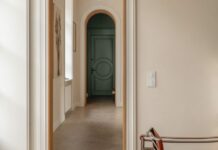[ad_1]
Laminate flooring is one of the most popular categories in the flooring world. It’s known for its easy installation, realistic wood looks, and affordable price compared to solid hardwood. But is it worth it? Let’s review the top 10 laminate flooring pros and cons to help answer that question.
Pros of Laminate Flooring

There are lots of reasons to love laminate. It’s the original wood-look flooring, so manufacturers have spent years perfecting the designs and features.
1. Easy DIY Installation
Laminate planks usually feature an interlocking design, which allows you to snap the planks together and install them without the need for glue or nails.
This also means you can “float” laminate over an existing subfloor, such as tile, without having to rip up your old floor. All in all, laminate is perfect for a home improvement project.
2. Affordable Pricing
Laminate flooring is much more budget-friendly than solid hardwood flooring. The price of laminate varies, but you can expect an average cost of $3 to $9 per sqft. High-end features like waterproofing contribute to a bigger price tag.
According to Forbes, hardwood flooring costs an average of $8 to $11 per sqft, with an average installation cost of $3 to 10 per sqft. When you add in the cost of maintenance, hardwood flooring is more than double the cost of laminate.
| Related Content >> Engineered Hardwood vs. Laminate |
3. Easy to Clean

If you want a floor with minimal maintenance, laminate is a great choice for you. Laminate comes with a durable wear layer that often protects against scuffs and stains. That means you can have effortlessly beautiful floors.
To keep laminate looking its best, simply sweep up any dust and dirt every week, and occasionally clean it with a lightly damp microfiber mop.
| Related Content >> How to Clean Laminate Flooring |
4. Durable Design
Laminate is built to be tough, whether you choose it for a commercial space or a busy home. Many options are built to resist scratches, stains, and fading. It can handle heavy traffic and is ideal for people with kids and pets.
Laminate flooring has an Abrasion Class (AC) rating that determines how much traffic it can handle.
- AC3: Good for high-traffic areas in your home and light traffic in commercial spaces
- AC4: Good for any residential application and medium traffic in commercial spaces
- AC5: Good for high-traffic commercial spaces
5. High-Quality Appearance
Laminate is the original wood-look flooring, and it continues to lead the pack with some of the most realistic visuals on the market. You can choose from high-quality looks that mimic the most stylish species, including Hickory and Oak.
Some laminate flooring is even embossed in register, which means the embossed texture on the surface perfectly matches the wood grain visuals for a highly realistic feel.
| Related Content >> Laminate Flooring Buying Guide: What You Should Know |
Cons of Laminate Flooring

Although laminate flooring comes with a lot of benefits, there are still some considerations you should be aware of. That way, you can make an informed decision about your new floor.
1. Moisture Issues
Laminate has a reputation for moisture damage when there’s excessive water. The high-density fiberboard (HDF) core can absorb water, which leads to swelling and warping. That’s why people typically avoid installing it in basements, bathrooms, and other high-moisture areas.
However, you can now choose water-resistant and even waterproof laminate flooring. You can also improve the moisture resistance of your floor by including a moisture barrier underneath it.
| Related Content >> Waterproof Laminate Flooring Buying Guide |
2. Can’t Refinish
With real wood, you may have the option to refinish your floor if it gets scratched or if you want to update the style.
But laminate is synthetic, and the surface layer is too thin to sand down and refinish. If you want to change the look of the floor, or if it’s starting to look worn, you’ll have to replace it.
3. Sustainability

Eco-friendliness is important to a lot of people, and there are some drawbacks to laminate.
Laminate contains plastic, and it won’t biodegrade. Low-quality laminate may also be made with glues that contain formaldehyde, and there’s a chance it can off-gas VOCs. To ensure you choose safe, high-quality laminate, look for products that are FloorScore® certified.
4. Hollow Sound
If you don’t install it correctly, laminate can sometimes have a noisy or hollow sound when you walk over it. To avoid that, make sure you follow the manufacturer’s instructions during installation.
Underlayment also helps with sound insulation, so you should always install underlayment beneath laminate flooring.
5. Resale Value
Some flooring, like hardwood, is virtually guaranteed to improve the resale value of your home. Laminate, while beautiful and durable, doesn’t always increase home value. It depends on the quality and style.
So, while laminate can sometimes improve the value of your home, it’s not as dramatic as solid hardwood or tile. That’s important to keep in mind, especially if you want to flip a house or dramatically upgrade your home value.
| Related Content >> Laminate Flooring Trends |
Conclusion

Now you know the biggest laminate flooring pros and cons. Laminate comes with a wide range of benefits, including realistic visuals and easy installation. But there are some important considerations to keep in mind, such as moisture resistance and refinishing.
If you’ve decided that laminate is the right choice for you, why not get started with some free samples?
Order Free Samples Shop All Laminate Flooring
The post 10 Laminate Flooring Pros and Cons: Learn the Essentials appeared first on Flooring Inc.
[ad_2]
www.flooringinc.com










